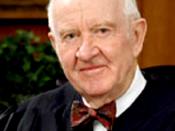John Paul Stevens, the 101st Justice to serve on the supreme court of the United States, and the first appointed by President Gerald R. Ford. John Paul Stevens became a member of the high court in December of 1975. Stevens, a middle aged man, with a reputation as a sharp-minded, hardworking lawyer, and first rate judge was given the highest evaluation from the American Bar Association committee that examined his record. "A superb judicial craftsman" and a Judgeùs judge," are two of the praises that Stevens has received from the United States Court of Appeals.
Stevens was voted into the supreme court with a vote of 98-0. In that time, Stevens was considered by the press, to be a moderate or moderate conservative in his legal thinking, and would take sides with other justices Powell, Stewart, and White.
John Paul was born on Apr. 20, 1920. Stevens, the youngest out of 4 sons, Stevens was also considered to be the smartest of the 4 .
At the age of six, his brother Ernest Stevens noted to a New York Post reporter, "I guess we always knew he was going to make something of himself. He was always awfully smart....When John was six, he could play better bridge then most adults today>"
Stevens attended the University of Chicago High School, and then later went to the University its self. In 1941, he left the University with a Phi Betta Kappa key, and a B.A. degree. He joined the navy, after the U.S entered World War 2. Stevens was stationed in Washington D.C, as a intelligence officer on the staff of admiral Chester W. Nimitz. He worked with a group assigned to break Japanese codes. for doing this, he was awarded the Bronze Star. After he returned to Chicago, (at the...


